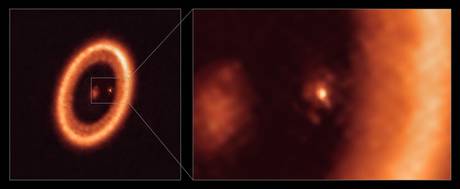Captured the first image of an embryo of the moon, it is a disc of matter that constitutes the first step towards the formation of a natural satellite around a planet outside the Solar System.
This is indicated by the study published in the Astrophysical Journal Letters, coordinated by astronomer Myriam Benisty, of the French University of Grenoble and by Miriam Keppler, of the German Max Planck Institute for Astronomy, and conducted in collaboration with the University of Chile. .
The images were obtained thanks to the Alma radio telescope (Atacama Large Millimeter / submillimeter Array), in Chile, of the Southern European Observatory (Eso). Observation will help to better understand how moons and planets are formed in young star systems.
The protagonist is a young gas giant planet similar to Jupiter discovered in 2019, called PDS 70c, which is located about 400 light years from Earth, in the constellation of Centaur.
The image captured by Alma shows a large disk of gas and dust from which the planet was formed, and its companion, PDS 70b, not visible in the photo.
At the center of the disk is the parent star PDS 70 around which the Jupiter-type planet orbits.
Not far from PDS 70c, hidden away, a second bright dot, surrounded by a halo of gas and dust: it is the disk from which one of its moon will originate.
On the left, the disk of poor and gas from which the planet PDS 70c was formed (the dot on the right). On the right, the detail of the planet, surrounded by a halo from which its moon is forming (source: ALMA, ESO / NAOJ / NRAO / Benisty et al.)
“Our work shows a clear identification of a disk where satellites could form,” notes Benisty. "Our observations with Alma were obtained with such fine resolution that we could clearly identify that the disk is associated with the planet, and define its size for the first time."
This tenuous disk around the planet, according to ESO astronomers' estimates, is about the same diameter as the distance separating the Earth from the Sun and has enough mass to form up to three Moon-sized satellites.
So far “more than 4,000 planets outside the solar system have been found, but all - Keppler notes - have been detected in advanced systems.
But PDS 70b and PDS 70c, a system reminiscent of the Jupiter-Saturn pair, are the only two worlds found so far still being formed.
This is why they offer us a unique opportunity to observe and study the formation processes of planets and satellites ”.
An even deeper understanding of the planetary system will be achieved with ESO's Extremely Large Telescope (ELT), which is expected to go live in 2025.

